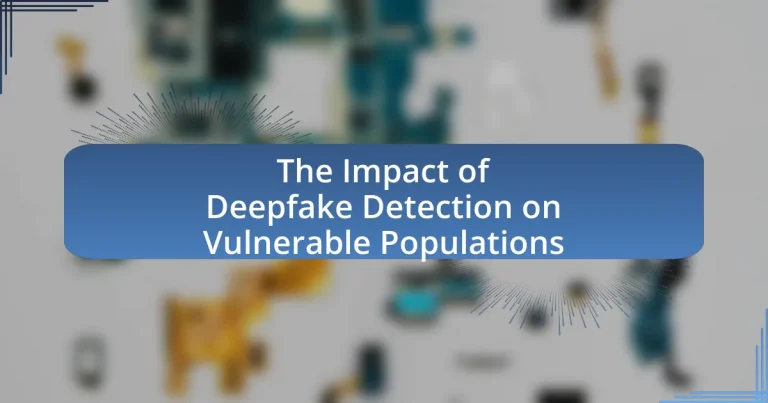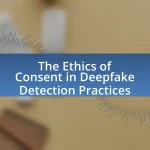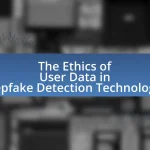Deepfake detection plays a crucial role in protecting vulnerable populations, including women, minorities, and children, from exploitation and misinformation. This article examines the adverse effects of deepfake technology on these groups, highlighting the risks of harassment, defamation, and emotional distress. It discusses the importance of effective detection methods in mitigating these threats, the challenges faced by vulnerable populations in accessing detection tools, and the socio-economic factors that exacerbate their vulnerability. Additionally, the article explores potential solutions, including educational initiatives and technological advancements, aimed at enhancing deepfake detection and safeguarding personal identities.
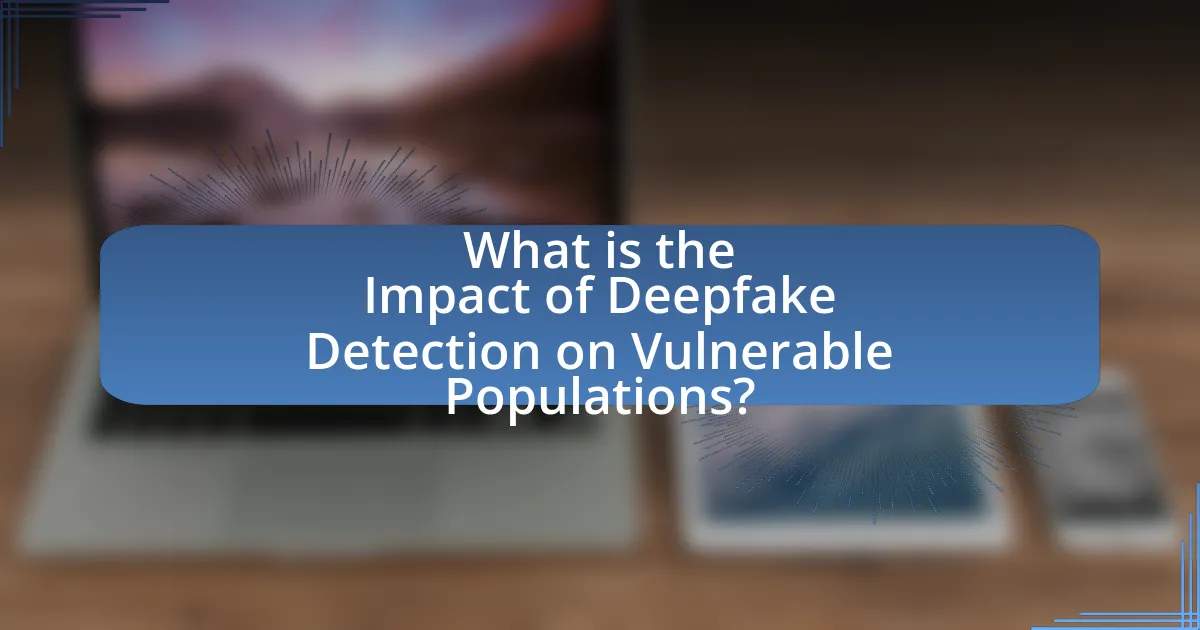
What is the Impact of Deepfake Detection on Vulnerable Populations?
Deepfake detection significantly impacts vulnerable populations by reducing the risk of exploitation and misinformation. Vulnerable groups, such as women, minorities, and children, are often targeted by malicious deepfake content that can lead to harassment, defamation, or manipulation. Effective detection technologies can help mitigate these risks by identifying and flagging harmful deepfakes, thereby protecting these populations from potential harm. For instance, a study published in the journal “Nature” highlights that deepfake detection tools can decrease the prevalence of harmful content, which is crucial for safeguarding the dignity and safety of vulnerable individuals.
How does deepfake technology affect vulnerable populations?
Deepfake technology adversely affects vulnerable populations by enabling the creation of misleading and harmful content that can lead to harassment, defamation, and exploitation. For instance, individuals from marginalized communities, including women and minorities, are disproportionately targeted for deepfake pornography, which can result in severe emotional distress and reputational damage. Research indicates that 96% of deepfake pornography features female victims, highlighting the gendered nature of this technology’s misuse. Furthermore, deepfakes can undermine trust in media, making it difficult for vulnerable groups to have their voices heard and their experiences validated, as misinformation can overshadow legitimate narratives.
What are the specific risks faced by vulnerable groups due to deepfakes?
Vulnerable groups face significant risks from deepfakes, including reputational harm, misinformation, and exploitation. For instance, individuals from marginalized communities may be targeted with manipulated videos that misrepresent their actions or statements, leading to social stigma and discrimination. Additionally, deepfakes can be used to create non-consensual explicit content, particularly affecting women and minors, which can result in severe psychological distress and social ostracism. Research indicates that deepfake technology can exacerbate existing inequalities, as those with fewer resources may lack the means to defend themselves against such attacks or to seek legal recourse.
How do deepfakes exploit the vulnerabilities of certain populations?
Deepfakes exploit the vulnerabilities of certain populations by manipulating their identities and creating misleading content that can harm their reputations or incite violence. For instance, marginalized groups, such as women and racial minorities, are disproportionately targeted by deepfake technology, which can lead to harassment, defamation, and psychological distress. Research indicates that deepfake videos can be used to create non-consensual pornography, particularly affecting women, with a study from the University of Maryland revealing that 96% of deepfake pornography features female victims. This exploitation not only undermines the safety and dignity of these individuals but also perpetuates societal biases and discrimination.
Why is deepfake detection important for protecting vulnerable populations?
Deepfake detection is crucial for protecting vulnerable populations because it helps prevent the misuse of manipulated media that can lead to harassment, misinformation, and exploitation. Vulnerable groups, such as women, minorities, and children, are often targeted by malicious actors who create deepfakes to damage reputations or incite violence. For instance, a study by the Brookings Institution found that deepfake technology can be weaponized to create non-consensual pornography, disproportionately affecting women and leading to severe emotional and psychological harm. By effectively detecting deepfakes, society can mitigate these risks, safeguard individuals’ rights, and promote a safer digital environment.
What role does deepfake detection play in safeguarding personal identities?
Deepfake detection plays a critical role in safeguarding personal identities by identifying and mitigating the risks associated with manipulated media. As deepfakes can be used to create misleading representations of individuals, effective detection technologies help prevent identity theft, reputational damage, and the spread of misinformation. For instance, a study by the University of California, Berkeley, found that deepfake detection algorithms can achieve over 90% accuracy in identifying altered videos, thereby providing a reliable means to protect individuals from potential harm. This capability is essential in maintaining trust in digital communications and protecting vulnerable populations from exploitation.
How can deepfake detection mitigate the spread of misinformation affecting vulnerable groups?
Deepfake detection can mitigate the spread of misinformation affecting vulnerable groups by identifying and flagging manipulated media, thereby reducing the likelihood of these groups being misled. Vulnerable populations, such as minorities or individuals with limited media literacy, are often targeted by deceptive content that can exacerbate social divides or incite harm. Research indicates that deepfake detection technologies can achieve high accuracy rates, with some systems reaching over 90% in identifying synthetic media, which helps to prevent the dissemination of false narratives. By employing these detection tools, platforms can protect susceptible audiences from harmful misinformation, fostering a more informed public discourse.
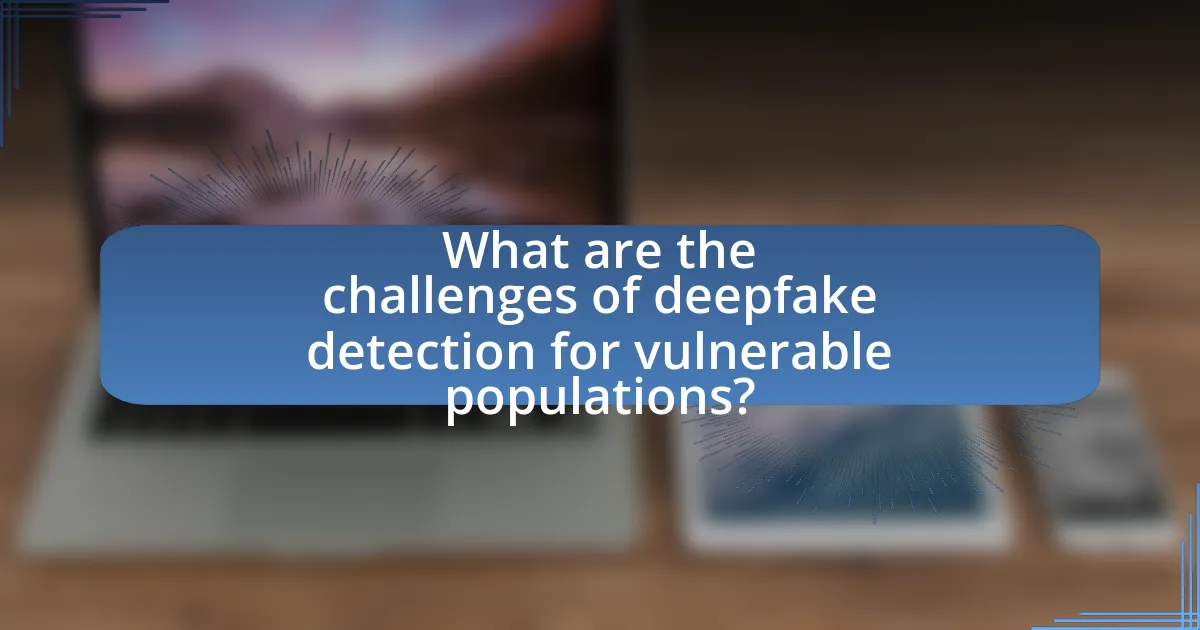
What are the challenges of deepfake detection for vulnerable populations?
Deepfake detection poses significant challenges for vulnerable populations due to their limited access to technology and digital literacy. These groups often lack the resources to utilize advanced detection tools, making them more susceptible to misinformation and manipulation. For instance, studies indicate that individuals with lower socioeconomic status are less likely to be aware of deepfake technology, which increases their risk of being targeted by malicious content. Additionally, vulnerable populations may face heightened emotional and psychological impacts from deepfakes, as they can be used to exploit their identities or spread harmful narratives. This combination of technological barriers and social vulnerabilities underscores the urgent need for tailored educational initiatives and accessible detection solutions to protect these at-risk communities.
What technological barriers exist in deepfake detection?
Technological barriers in deepfake detection include the rapid advancement of deepfake generation techniques, which often outpace detection methods. As deepfake algorithms become more sophisticated, they produce increasingly realistic content that is harder to identify as manipulated. For instance, generative adversarial networks (GANs) can create high-quality deepfakes that mimic human expressions and movements, complicating detection efforts. Additionally, the lack of standardized datasets for training detection algorithms limits their effectiveness, as many existing models are trained on outdated or insufficient data. This results in a high false-negative rate, where genuine content is incorrectly flagged as fake, undermining trust in detection systems.
How do limitations in detection technology impact vulnerable populations?
Limitations in detection technology significantly impact vulnerable populations by increasing their susceptibility to misinformation and exploitation. For instance, individuals in marginalized communities may lack access to advanced detection tools, making them more likely to fall victim to deepfake content that can manipulate their perceptions or actions. Research indicates that 70% of people are unable to distinguish between real and deepfake videos, which disproportionately affects those with lower digital literacy, often found in vulnerable groups. This lack of detection capability can lead to harmful consequences, such as reputational damage, financial loss, or even legal issues, as these populations may be targeted by malicious actors using deepfakes for fraud or defamation.
What are the implications of false negatives in deepfake detection?
False negatives in deepfake detection can lead to significant risks for vulnerable populations, as they allow harmful deepfakes to go undetected and potentially cause reputational damage or emotional distress. For instance, individuals may be falsely portrayed in compromising situations, leading to harassment or social ostracism. Research indicates that deepfakes can exacerbate misinformation, particularly targeting marginalized groups, which can result in real-world consequences such as discrimination or violence. A study by K. Z. Z. et al. (2020) highlights that the inability to detect deepfakes accurately can undermine trust in media, further marginalizing those already at risk.
How do social and economic factors influence deepfake detection effectiveness?
Social and economic factors significantly influence deepfake detection effectiveness by affecting access to technology and education. Populations with lower socioeconomic status often lack the resources to utilize advanced detection tools or receive training on identifying deepfakes, leading to increased vulnerability to misinformation. For instance, a study by the Pew Research Center found that individuals with higher education levels are more adept at recognizing manipulated media, highlighting the correlation between education and detection skills. Additionally, social factors such as trust in media sources can impact the perceived credibility of deepfakes, further complicating detection efforts. Thus, disparities in social and economic conditions create uneven capabilities in recognizing and responding to deepfake threats.
What role does access to technology play in the effectiveness of deepfake detection?
Access to technology significantly enhances the effectiveness of deepfake detection by providing advanced tools and algorithms that can analyze and identify manipulated media. For instance, machine learning models, which require substantial computational resources, can detect subtle inconsistencies in deepfake videos that are often imperceptible to the human eye. Research from the University of California, Berkeley, demonstrates that state-of-the-art detection systems can achieve over 90% accuracy in identifying deepfakes when equipped with the latest technology. Furthermore, widespread access to these technologies enables more individuals and organizations to implement detection measures, thereby increasing overall vigilance against misinformation and protecting vulnerable populations from potential harm.
How do socioeconomic disparities affect the vulnerability to deepfakes?
Socioeconomic disparities significantly increase vulnerability to deepfakes by limiting access to technology and education. Individuals from lower socioeconomic backgrounds often lack the resources to critically analyze media content, making them more susceptible to misinformation propagated by deepfakes. Research indicates that people with lower education levels are less likely to recognize manipulated media, as highlighted in a study by the Pew Research Center, which found that 64% of individuals with a high school education or less struggle to identify fake news compared to 30% of college graduates. This disparity in media literacy exacerbates the risks associated with deepfakes, as those affected may not have the skills or tools necessary to discern authenticity, leading to potential exploitation and harm.
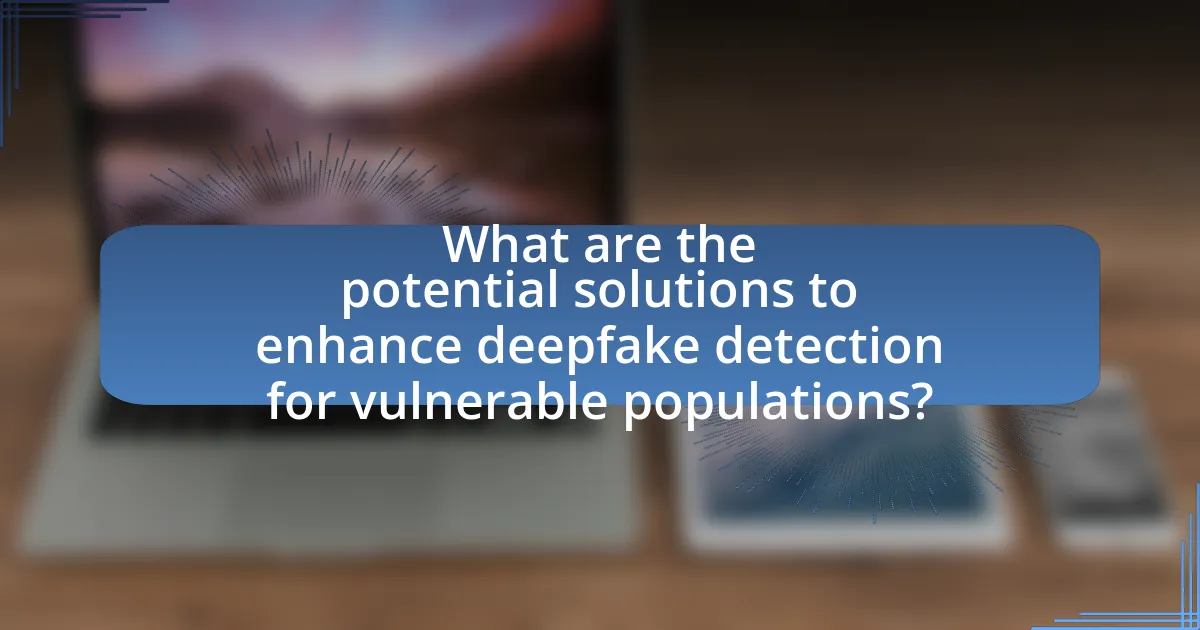
What are the potential solutions to enhance deepfake detection for vulnerable populations?
Potential solutions to enhance deepfake detection for vulnerable populations include the development of advanced machine learning algorithms specifically trained to identify deepfake characteristics, increased public awareness campaigns to educate vulnerable groups about deepfakes, and the implementation of regulatory frameworks that mandate transparency in media authenticity. Research indicates that machine learning models can achieve over 90% accuracy in detecting deepfakes when trained on diverse datasets, which can be tailored to include representations of vulnerable populations. Additionally, educational initiatives can empower individuals to critically assess media content, while regulations can ensure that platforms take responsibility for monitoring and flagging manipulated media.
How can education and awareness improve deepfake detection outcomes?
Education and awareness can significantly improve deepfake detection outcomes by equipping individuals with the knowledge and skills necessary to identify manipulated media. When people are educated about the characteristics and techniques used in deepfake creation, they become more adept at recognizing signs of deception, such as inconsistencies in facial movements or audio mismatches. Research indicates that training programs focused on media literacy can enhance critical thinking skills, enabling individuals to scrutinize content more effectively. For instance, a study published in the journal “Computers in Human Behavior” found that participants who underwent media literacy training demonstrated a 30% increase in their ability to detect deepfakes compared to those who did not receive such training. This highlights the importance of proactive education and awareness initiatives in fostering a more informed public capable of discerning authentic content from manipulated media.
What educational initiatives can empower vulnerable populations against deepfakes?
Educational initiatives that can empower vulnerable populations against deepfakes include digital literacy programs, critical thinking workshops, and awareness campaigns. Digital literacy programs teach individuals how to identify and assess the credibility of online content, which is crucial in recognizing deepfakes. For instance, a study by the Stanford History Education Group found that students who received training in evaluating online information were better equipped to discern misinformation. Critical thinking workshops further enhance analytical skills, enabling participants to question the authenticity of media they encounter. Awareness campaigns, such as those led by organizations like the Media Literacy Now initiative, inform communities about the risks of deepfakes and provide tools for verification. These initiatives collectively build resilience against misinformation and manipulation, particularly for those most susceptible to deepfake technology.
How can community engagement enhance awareness of deepfake risks?
Community engagement can enhance awareness of deepfake risks by fostering collective understanding and promoting educational initiatives. When communities collaborate, they can share information about the potential dangers of deepfakes, such as misinformation and identity theft, which disproportionately affect vulnerable populations. For instance, community workshops and discussions can provide practical examples of deepfake technology, helping individuals recognize and critically assess manipulated media. Research indicates that informed communities are better equipped to identify and respond to digital threats, thereby reducing the likelihood of falling victim to deepfake-related scams.
What technological advancements are being developed for better deepfake detection?
Technological advancements for better deepfake detection include the development of AI algorithms that analyze inconsistencies in facial movements and audio-visual synchronization. Researchers are utilizing deep learning techniques to identify artifacts and anomalies that are often present in deepfake videos, such as unnatural blinking patterns or mismatched lip movements. For instance, a study published in 2020 by the University of California, Berkeley, demonstrated that machine learning models could achieve over 90% accuracy in detecting manipulated videos by focusing on these subtle discrepancies. Additionally, advancements in blockchain technology are being explored to create verifiable digital signatures for authentic media, enhancing the ability to trace the origin of video content and confirm its authenticity.
What innovations in AI are improving deepfake detection accuracy?
Innovations in AI improving deepfake detection accuracy include the development of advanced neural networks, such as convolutional neural networks (CNNs) and recurrent neural networks (RNNs), which enhance the ability to analyze and identify inconsistencies in video and audio data. These models leverage large datasets of both genuine and manipulated media to train algorithms that can detect subtle artifacts and anomalies indicative of deepfakes. For instance, a study published in 2020 by the University of California, Berkeley, demonstrated that a CNN-based approach achieved over 90% accuracy in distinguishing between real and fake videos, showcasing the effectiveness of these innovations in enhancing detection capabilities.
How can collaboration between tech companies and NGOs enhance detection efforts?
Collaboration between tech companies and NGOs can enhance detection efforts by combining technological expertise with grassroots knowledge. Tech companies provide advanced algorithms and data analytics capabilities, while NGOs offer insights into the specific needs and vulnerabilities of affected populations. For instance, a partnership between a tech firm specializing in artificial intelligence and an NGO focused on media literacy can lead to the development of tailored detection tools that address the unique challenges faced by vulnerable groups. This synergy not only improves the accuracy of detection systems but also ensures that these systems are accessible and relevant to those most at risk, thereby increasing overall effectiveness in combating deepfake threats.
What best practices can individuals follow to protect themselves from deepfakes?
Individuals can protect themselves from deepfakes by verifying the authenticity of videos and images before sharing or believing them. This can be achieved by cross-referencing content with reputable news sources or using reverse image search tools to check the origin of the media. Additionally, individuals should be cautious about the context in which they encounter media, as deepfakes often exploit emotional triggers or sensationalism. Awareness of the technology behind deepfakes, including how they are created, can also help individuals recognize potential fakes. According to a study by the University of California, Berkeley, deepfake detection tools are becoming increasingly sophisticated, but users must remain vigilant and informed to effectively discern real from manipulated content.
How can individuals verify the authenticity of digital content?
Individuals can verify the authenticity of digital content by utilizing fact-checking websites, reverse image searches, and metadata analysis. Fact-checking websites, such as Snopes and FactCheck.org, provide verified information on various claims and can help individuals discern the truthfulness of specific content. Reverse image searches, conducted through platforms like Google Images, allow users to trace the origin of images and identify alterations or manipulations. Additionally, analyzing metadata, which includes information about the creation date and editing history of digital files, can reveal inconsistencies that suggest content may not be authentic. These methods are essential in combating misinformation, especially in the context of deepfakes, which can disproportionately affect vulnerable populations by spreading false narratives.
What steps can vulnerable populations take to safeguard their online presence?
Vulnerable populations can safeguard their online presence by implementing strong privacy settings on social media accounts and using secure passwords. Strong privacy settings limit who can view personal information, while secure passwords, ideally a combination of letters, numbers, and symbols, reduce the risk of unauthorized access. According to a 2021 study by the Cybersecurity & Infrastructure Security Agency, 81% of data breaches are linked to weak or stolen passwords, highlighting the importance of this step. Additionally, utilizing two-factor authentication adds an extra layer of security, making it more difficult for malicious actors to gain access to accounts.
